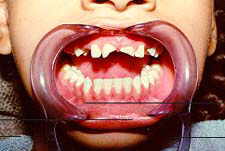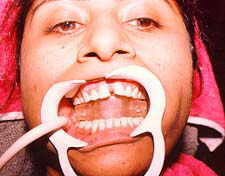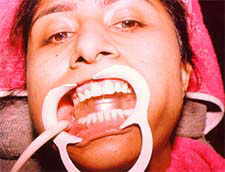Introduction: One of the greatest assets a person can
have is a smile that shows beautiful, natural teeth. Missing or unesthetic teeth, often
lead to a conscious effort to avoid smiling, and other defence mechanisms are used to
"cover up" the teeth. The positive psychological effects of improving a
patient’s smile often contribute to an improved self- image and enhanced self-
esteem. Dentistry has always enjoyed the distinction of being a blend of art and science,
and aesthetic dentistry is the art in its purest form. The restoration of a smile is one
of the most appreciated and gratifying services a dentist can render, and the branch of
dentistry that deals with this is called AESTHETIC DENTISTRY.

Peg shaped lateral incisor(Upper right)
All individuals should maintain a healthy mouth, by following a daily home- care
routine, a balanced diet, and regular recall 6 monthly visits to the dentist. Carious
teeth, periodontally involved teeth, food habits etc can lead to aesthetically
unacceptable teeth and smile.
The following article shall discuss each of the unesthetic situation their
cause, their possible prevention and their treatment under each heading.
Stains: Can be either extrinsic of intrinsic. Extrinsic stains are due to
intake of foodstuff, such as excess intake of tea or coffee, life style habits e.g.
smoking, tobacco or pan chewing. Intrinsic stains are due to physical environment such
excess fluoride in water, medicaments for example tetracycline, trauma or general systemic
conditions such as congenital porphyria, erthroblastosis fetalis etc.
Trauma: can result in conditions from pulp hyperemia to severe fracture
involving the entire tooth. Fractures of the tooth could be small chipping of the incisal
edge to severe fractures involving the pulp in varying degrees with or without involving
the root.
Aesthetic dentistry offers various treatment modalities, from simple procedures
such as conservative alterations of tooth contours and contacts, (cosmetic re- contouring)
with the use of composite materials to bleaching(whitening) and invasive procedures such
as laminates/veneers, crowns and bridges.

After recountering with composite resins.
Bleaching (tooth whitening): Involves the application of a chemical
(oxidizing) solution to the teeth. Bleach solution permeates into enamel or dentin and
oxidises the molecules of staining. Applying heat or a combination of heat and light
further enhances the reaction. Generally, three or more sittings are required to attain
the desired effect. The main objective of bleaching is to restore the normal color of the
tooth by decolorizing the stain with a powerful oxidizing or reducing agent. The main
bleaching agents used are 30% solution of hydrogen peroxide (superoxol), sodium perborate
10% and carbamine peroxide 10-15%. The number of applications, duration differ as per the
needs of the individual patients. ,10 or15% carbamine peroxide is now used by patients at
home in a custom made tray under supervision of Dental surgeon . An impression of patients
teeth is all that is required for the trays and the gel is dispensed to the patient with
trays. Whitening has become easier and more popular as the patients does not need to visit
the clinic time and again. People use teeth whiteners even before going for a party now!!
The main advantages of bleaching is no loss of tooth structure and
usually low cost as compared to other procedures. The disadvantage is that it is more
time- consuming as compared to bonding or veneering. Also occasional touch - ups may be
necessary to keep the teeth white.
Composites: These tooth-colored material in lay language
can be described as durable plastic compound (resins) that look like ceramic. It is due to
their superior physical properties, particularly strength and reduced solubility that has
made composites popular. A process called ‘bonding’ is used which involves
etching the tooth surface using a mild acid solution, which allows composite resins to
adhere mechanically.
To get the desired color various standard shades of the resins are carefully
blended so the bonded tooth will look completely natural and as close as possible to the
natural teeth.
After application, the resin is contoured into the proper shape and hardens. If
the resin is self- cured then it hardens by chemical reaction and if it is light- cured
then it is hardens on activation by ultra violet light as the manufacturer specifies, a
specific range of visible light. It is then smoothened and polished to achieve the desired
form.
The main advantage is that it is a virtually painless, can be usually completed
in one or two visits, little or no tooth reduction, less expensive than crowning and
avoids potential pulp or gingival irritation. The following procedures are usually carried
out with composite resins.

Broken incisor

After repair with resin
- Composite Recontouring: Frequently, minor modification of existing tooth
contours can effect a significant change, this is known as cosmetic recontouring. For
example reshaping enamel by rounding incisal angles, opening incisal embrasures, and
reducing prominent facial line angles can produce a more femine, youthful appearance in a
female patient. One of the photographs here shows cosmetic recontouring of a peg shaped
tooth which was recontoured to look like a beautiful incisor. This is done with composite
resins.(photographs 1 & 2)
- Broken Teeth Repairs:
Your patient has had an accident and has chipped his
teeth. No problem- with resins the patient can look normal within an hour. One of the
photoghaphs here shows how good a repair can look.(photographs 3 & 4)
- Gap Closures:
Many patients have ugly looking gaps in teeth. These could
again be closed by bonding resins to the sides of the teeth.(see photograph 5 & 6)

Midline gap between teeth

Gap closed with composite resins.
- Complete Smile Change:
Many patients have irregular ugly looking teeth but do
not wish to under take extensive procedures. Composites come in handy here. In one or two
sittings they can get a more youthful smile with some recontourings, gap closure etc.
Laminates/Veneers: A veneer is a layer of tooth colored material that is
applied to a tooth for aesthetically restoring localised or generalised defects or
intrinsic discoloration’s.
Laminating is an extension of the bonding technique. It consists of applying
veneers, these are thin pre- fabricated shells made of tooth- coloured materials typically
made of chair side composite, processed composite, porcelain, or cast ceramic materials,
that are bonded to the surface of a tooth to mask malformation, discoloration, abrasion,
erosion and faulty restorations.
The best results in terms of resistance to wear, aesthetics and cleansability
are obtained from ceramic or porcelain veneers, with less chipping, less staining than
bonded restorations. It is a more conservative approach and less expensive as compared to
crowning, Though once veneered, they must either be periodically re- veneered or crowned
if failure occurs or if decay develops adjacent to the veneers.
A crown is fixed prosthodontic restoration that covers or ‘caps’ a
tooth completely, and is the most extensive form of treatment, as the entire tooth surface
has to be ‘reduced’ and prepared to fit the crown.
They are used both cosmetically and therapeutically - to improve the appearance
(a) of hypoplastic teeth, (b) of permanently stained teeth, © of teeth with excessive
tooth loss due to attrition, abrasion and erosion, (d) to protect root canal treated tooth
from fracture. These help in restoring the tooth to its functional form. Bridges are used
to replace missing teeth. Here the adjacent teeth are crowned and those crowns support the
replaced teeth in between.
The most popular choice of crown and bridge modality is metal - fused to ceramic
(MFC) which can resolve most of these cases because of its superior aesthetic and high
strength. Certain anterior situations not demanding greater strength can tackled using all
ceramic crown restorations. Here shade matching is most critical, as the shade of the
tooth stalk/stump has to be camouflaged to create superior aesthetics. Lately ceromers
based system are becoming popular as aesthetic restoration because of minimal in - office
time and lesser laboratory involvement.
Conclusion: Aesthetic dentistry is the most challenging and demanding of
treatment modalities, however, the most rewarding too. A choice between the most radical,
and the most conservative has to be wisely made, taking into consideration the type,
amount and the surface(s) involved, the economic factor and the skills of the dentist to
achieve a pleasing result.